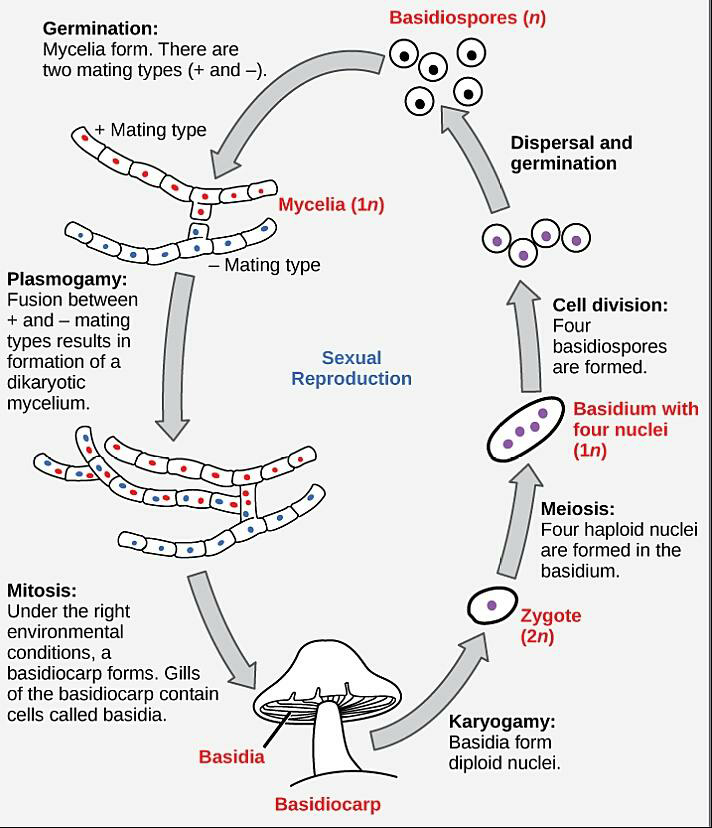
With the help of a neat diagram describe the life history of a mushroom.
Answer
436.8k+ views
Hint: Mushroom is a club-shaped, fleshy, spore-bearing fruiting body present in the Basidiomycetes fungi. It is also known as ‘gilled fungi'.
Complete answer:
-The mushroom is a typical example of Basidiomycetes. Some of the varieties of mushrooms are Puffballs, Morels, Truffles, Stinkhorn, etc.
-The fruiting bodies of basidiomycetes are known as basidiocarps which bear the spore-producing cells called basidia (singular- basidium). These basidia are present inside the gills.
-The reproductive cycle in mushrooms starts with the formation of a diploid zygote by the fusion of two compatible nuclei (karyogamy) in the basidia present inside the basidiocarp.
-The zygote undergoes meiosis to form four haploid basidiospores.
-The basidiospores germinate to give rise to monokaryotic hyphae. These hyphae together form the Primary mycelia.
-The mycelium of different strains cluster to form the Secondary mycelium. Each secondary mycelium contains two compatible mating nuclei. This represents the dikaryotic stage of the mushroom.
-The secondary mycelia gradually grow and differentiate under the suitable condition to form a new basidiocarp and the cycle continues.
-The newly formed basidiocarp (mushroom) bears the basidia under its cap.
-The formation of the fruiting bodies takes place only at the end of the life cycle and that too for a few days only.

Note:
This mode of life cycle involving both the haploid and diploid phase of life is known as ‘Alternation of the generation’. In basidiomycetes like mushrooms, the dominant phase is dikaryotic or diploid. It is represented by the zygote formed from the secondary mycelia whereas the basidiospores represent the haploid or the monokaryotic phase.
Complete answer:
-The mushroom is a typical example of Basidiomycetes. Some of the varieties of mushrooms are Puffballs, Morels, Truffles, Stinkhorn, etc.
-The fruiting bodies of basidiomycetes are known as basidiocarps which bear the spore-producing cells called basidia (singular- basidium). These basidia are present inside the gills.
-The reproductive cycle in mushrooms starts with the formation of a diploid zygote by the fusion of two compatible nuclei (karyogamy) in the basidia present inside the basidiocarp.
-The zygote undergoes meiosis to form four haploid basidiospores.
-The basidiospores germinate to give rise to monokaryotic hyphae. These hyphae together form the Primary mycelia.
-The mycelium of different strains cluster to form the Secondary mycelium. Each secondary mycelium contains two compatible mating nuclei. This represents the dikaryotic stage of the mushroom.
-The secondary mycelia gradually grow and differentiate under the suitable condition to form a new basidiocarp and the cycle continues.
-The newly formed basidiocarp (mushroom) bears the basidia under its cap.
-The formation of the fruiting bodies takes place only at the end of the life cycle and that too for a few days only.

Note:
This mode of life cycle involving both the haploid and diploid phase of life is known as ‘Alternation of the generation’. In basidiomycetes like mushrooms, the dominant phase is dikaryotic or diploid. It is represented by the zygote formed from the secondary mycelia whereas the basidiospores represent the haploid or the monokaryotic phase.
Recently Updated Pages
How do you factor x2 + x 20 0 class 9 maths CBSE

How do you solve y6x and 2x+3y20 using substitutio class 9 maths CBSE

Chipko movement originated in Gopeshwar in A 1953 B class 9 biology CBSE

The adjacent sides in the parallelogram are supplementary class 9 maths CBSE

The compound used in plastic industry is A Vinyl acetate class 9 chemistry CBSE

How do you solve for y in 2left y dfrac12 right 4left class 9 maths CBSE

Trending doubts
According to Bernoullis equation the expression which class 11 physics CBSE

Draw a diagram of nephron and explain its structur class 11 biology CBSE

Differentiate between calcination and roasting class 11 chemistry CBSE

A solution of a substance X is used for white washing class 11 chemistry CBSE

What is spore formation class 11 biology CBSE

10 examples of friction in our daily life




